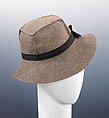Hat
Designer Sally Victor American
Not on view
During the 1930s, '40s and the early '50s, when hats were considered required accessories for well-dressed women, Sally Victor was among the foremost American milliners. Creative and very successful for almost 40 years, Victor began her prolific millinery career in 1927. She was one of the original members of the Edward C. Blum Design Laboratory, and often used the Brooklyn Museum's varied collections to draw inspiration for her designs. She was so connected with the Design Lab that she participated in several collaborative exhibitions and the museum often used her designs in publicity materials to exemplify how the Lab could benefit designers by providing inspiration. Her work is characterized by a special quirkiness that could often be traced back to interesting sources such as Native American tribes, the artist Henri Matisse or Japanese armor. She also combined traditional hat-making materials such as felt and silk with new synthetic materials in unique ways. According to her May 16, 1977 obituary in the "New York Times," Victor described her mission simply as "designing pretty hats that make women look prettier."
A perfect accompaniment for the man-tailored architectural suits favored by the 1930s woman, this architectural hat combines geometry and asymmetry in one fashionable design. The non-conventional construction, particularly of the crown, is demonstrative of Victor's innovative and whimsical aesthetic. Victor has taken the masculine fedora form and wittily executed it in bankers gray felt, commonly seen in men's suits. Many women’s hats of the period were sweetly feminine, incorporating flowers, veiling and bright colors, and, with this design, Victor offers an alternative to the ultra feminine styles.
Due to rights restrictions, this image cannot be enlarged, viewed at full screen, or downloaded.

